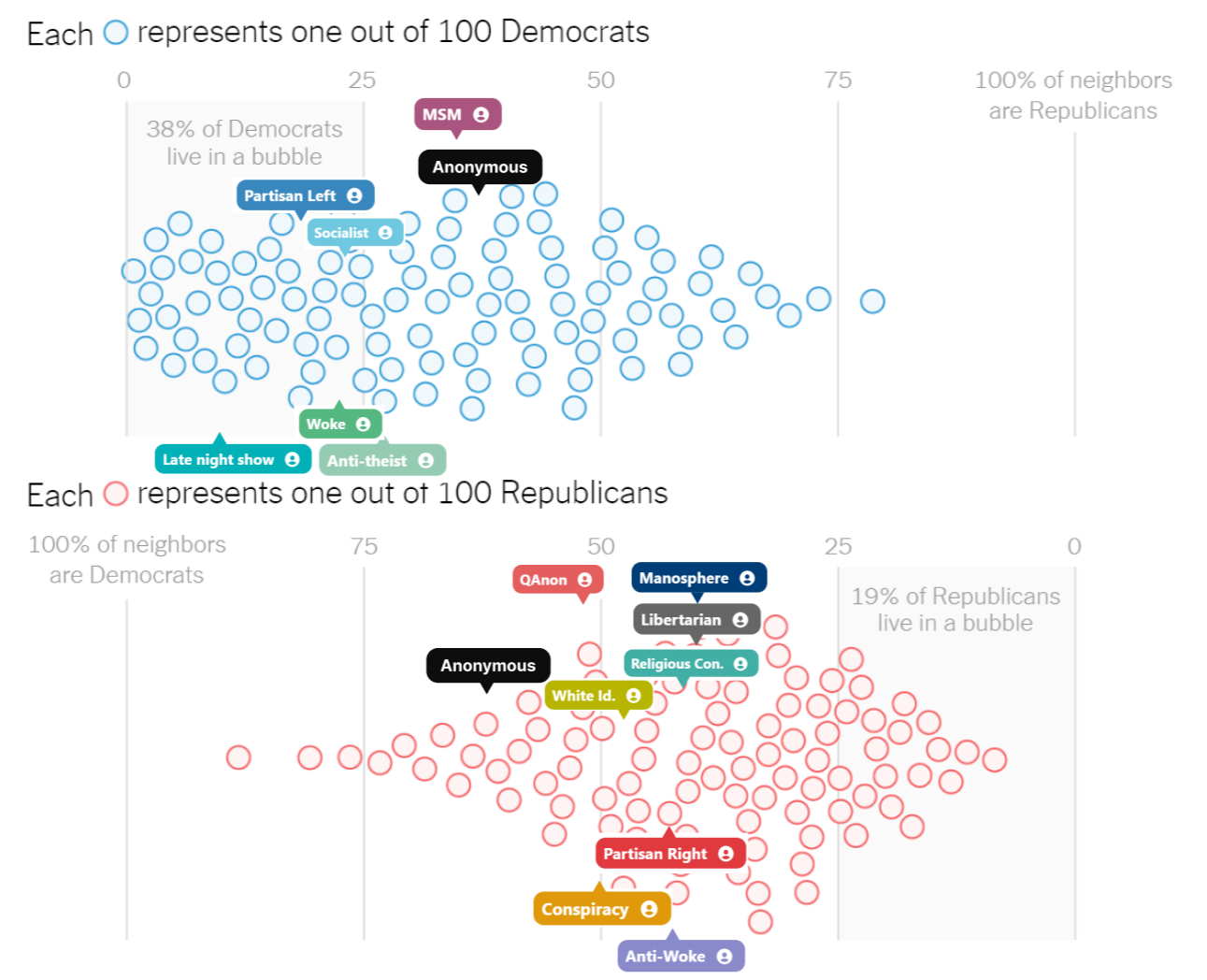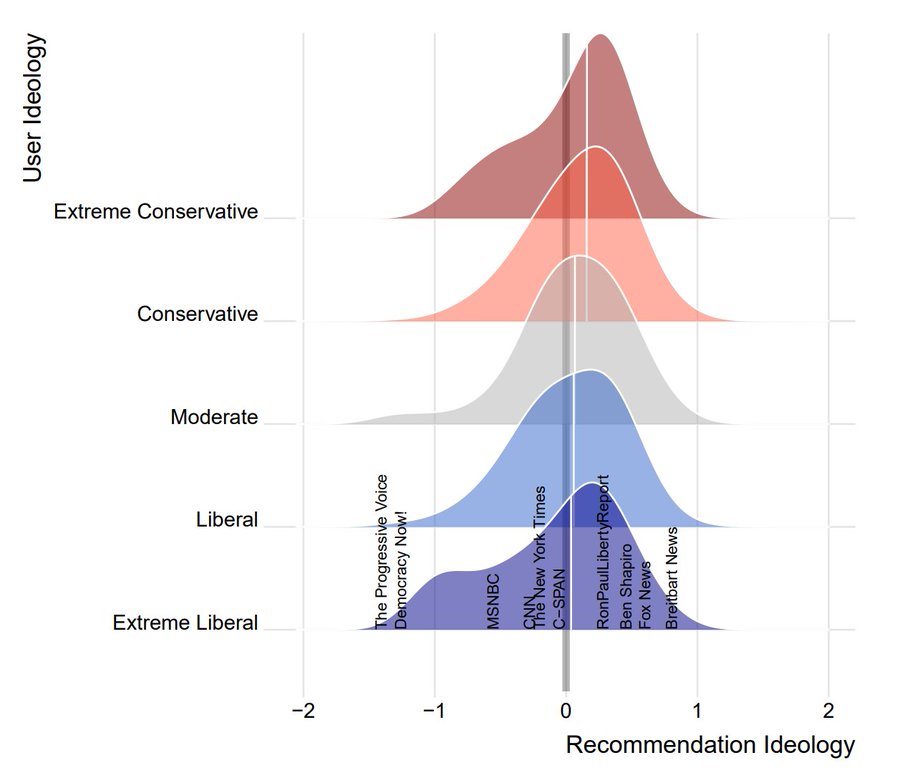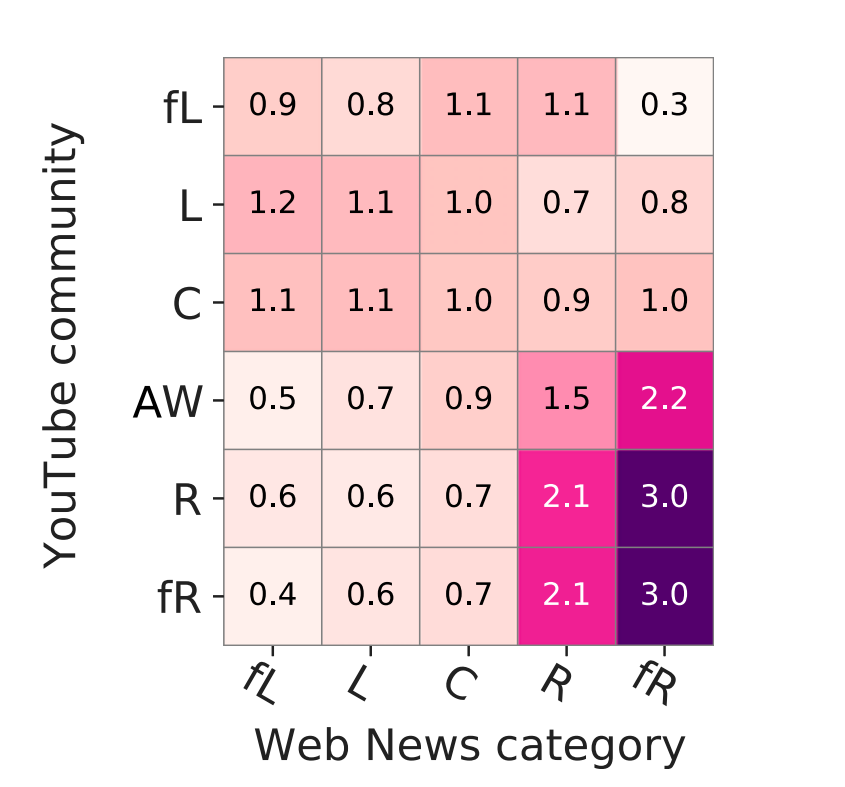YouTube influences your video-watching behavior by deciding which videos to recommend on the home page and next to videos.
We created 14 personas — each with their own watch history exclusive to a political niche — to see how YouTube tailors their recommendations.
Author: Mark Ledwich
From Sep 2020 through to Feb 2021, we forced each of our 14 personas to log in and watch YouTube videos.
Each day we chose recent videos from their favorite channels to build a persona that was currently watching exclusively within their "bubble". Here are a sample of the video's watched - click show all to see a persona's full watch history.
Full disclosure: As you can see, some of these persona-bots were obviously harmed, but it was decided this was for the greater good
We then subjected them to a common sample of videos so the recommendations could be compared like-for-like. History was disabled so that the viewing of the common sample would not impact personalization. Video's younger than 7 days old were chosen at random (proportional to views) from our dataset of news, politics and culture-war channels. We also included an anonymous viewer as a baseline to compare the influence of personalization.
Here is a sample of raw video recommendations, which is helpful to get get a sense of the recomendation system before analyzing the overall results.
These are the recommendations shown to the Partisan Left, Partisan Right and an Anonymous persona's when watching the 1st Presidential Debate 2020. In this venn diagram, you can see how much overlap of recommendations there are between the personas. Both their history and the video being watched influences the recommendations.
Trump and Biden face off in chaotic first 2020 presidential debate | FULL DEBATE
CBS News
recommendations from 5 videos
Recommendations seen on the Presidential Debate video show a gentle influence from personalization.
The Partisan Right persona saw the most Fox recommendations and is the only persona here to see Ben Shapiro, PragerU and the Regan foundation.
The Partisan left persona saw the most amount of left leaning news, like CNN and late night talk shows. Partisan left & right shared about half of their recommendations.
The Anonymous persona was shown mostly MSM videos related to the presidential debate, with ABC views featured to the most.
Here are Social Justice and Anti-Woke personas watching the same videos. There are similar levels of personalization to the previous personas. Most video's shown are related to the debate or the candidates, but there is usually a portion of unrelated videos from a persona's favorite channels.
Lastly, the Late Night Talk Show and Manosphere personas. These are the most "bubbled" groups of our persona's for the presidential debate recommendations (and also in general). I suspect that this is not special to the type of content, but they have less variety of channels to watch and as such they have a stronger signal to the recommendation system.
During this process we noticed that some channels, like TEDx Talks and the The Obama White House are given a special status by YouTube and all video recommendations guaranteed to stay within the channel.
If you are interested in exploring, use the filter controls bellow to filter recommendations shown to any combination of channels and persona's. Click RANDOM to see a random channels recommendations. Otherwise, just keep scrolling down.
Trump and Biden face off in chaotic first 2020 presidential debate | FULL DEBATE
CBS News
recommendations from 5 videos
Overall Influence of Personalization
Home page
On the home page, the personas were presented with 34% of videos from channels they had watched within their bubble - much more tailored than the up-next recommendations. This might be less than you see in your own experience because our persona's didn't subscribe to any channels, which would be featured more frequently.
19% of video's shown to the anonymous user were towards one of the channels in our dataset (i.e. they are mainly focused on news, politics or the culture war), 11% of those were Mainstream news. Our persona's were shown much more political content than an anonymous user — 47% — mostly to channels they had previously watched.
Up-next Videos
When our persona's were presented up-next video recommendations, on average:
-
16% were for channels within their bubble, 11% of those channels they had already watched
-
16% were back to the same channel they were watching
-
73% were to channels they hadn't seen before
There was plenty of variety in up-next recommendations, even for the same video. When our anonymous user watched the same video in the same week, only 16% of recommendations were repeated. When our persona's re-watched a video there were 10 percentage points more repeated recommendations - a mildly more consistent influence. When they watched different videos on the same day, there were 20 points less repeated recommendations vs watching the same video - showing that the video is having a larger impact on recommendations than who is watching it.
Ideological Influence of Personalization
Now we'll be looking at the personalization and influence of recommendations by breaking them down by the persona watching and the the category of video they lead to.
-
% of persona recommendations: the percent of all recommendations show to this persona. Note that these add up to more than 100% because recommended video categories overlap with each other (e.g. a video's channel can be bother MSM and Partisan Left).
-
vs video views:
[% of recommendations] - [% of total video views]. This is for comparison vs a simple/neutral algorithm which would recommend proportional to views. -
vs anonymous:
[% of recommendations] - [% equivalent anonymous recommendations]. A comparison to a user which is not logged in.
Here is a comparison of which political categories of the recommendations, starting with what was shown to an Anonymous user.
Most recommendations shown to an Anonymous user are towards Non-Political and Mainstream News. Overall, the recommendation influence is not too far from neutral when compared to the views of the channels being recommended. With this as a baseline, how does personalization impact recommendations?
The Partisan Left persona saw partisan left videos 45 percentage points more compared to an anonymous viewer on their home page, and 16 points more when watching videos. The other categories are less impacted, surprisingly Mainstream News received 31 points less home page recommendations despite sharing a lot of ideological overlap in content.
The Partisan right persona sees partisan right videos 34 points more than anonymous on the home page and 9 points more on videos - less personalization than the partisan left persona. Mainstream news, Partisan left and Social Justice video's are recommended less frequently.
The Late night talk show persona's within-bubble recommendations are 41% more than the anonymous viewer - by far the most dramatic personalization of all the personas. It's not clear that YouTube is treating this content differently, it could be that because the amount of channels within this bubble is very small, so the algorithm might perceive a stronger signal is what the persona watched compared to the others.
The Conspiracy personas within-bubble recommendations are 17 percentage points higher than an anonymous viewer on the home page and only 1.6 points higher on videos. The conspiracy personas video recommendations are very similar to an anonymous user.
Here is the same data for all persona's (left) towards videos (top). The table takes a little effort to understand, but is easier to spot patterns.
percentage point difference between persona's recommendations and an anonymous viewer - Video
| Anti-Woke | Anti-theist | Conspiracy | Late night show | Libertarian | Manosphere | MSM | Partisan Left | Partisan Right | QAnon | Religious Con. | Woke | Socialist | White Id. | Non-political | |
|---|---|---|---|---|---|---|---|---|---|---|---|---|---|---|---|
| Anti-Woke | 8.2 | 0 | -1.2 | -1.4 | 0.6 | 0.2 | -12 | -7.5 | 1.3 | -0.1 | 1.5 | -3.5 | -0.2 | 0 | 7.6 |
| Anti-theist | -0.4 | 11 | -1.4 | 1.3 | -0.4 | -0.1 | -11.1 | 0.3 | -5.1 | -0.1 | -0.8 | -0.3 | 0.2 | 0 | 2.9 |
| Conspiracy | -0.6 | -0.1 | 1.6 | -1 | -0.2 | 0 | -7.9 | -6.6 | 2.2 | 0.1 | 2.9 | -2.9 | -0.3 | 0 | 8.9 |
| Late night show | -3.8 | -0.3 | -1.4 | 27 | -0.6 | -0.2 | -20.4 | 21 | -10.3 | -0.1 | -1.7 | 7.7 | -0.4 | 0 | 4.8 |
| Libertarian | 2.7 | -0.2 | -0.9 | -1 | 7.5 | -0.1 | -9.2 | -7.4 | 2.3 | 0 | 0.5 | -3.3 | -0.3 | 0 | 5.6 |
| Manosphere | 2.6 | -0.2 | -1.3 | -1.2 | -0.3 | 9.1 | -7 | -7.1 | -1 | -0.1 | 0 | -3.3 | -0.3 | 0 | 1.5 |
| MSM | -2.3 | -0.2 | -1.3 | -1 | -0.3 | -0.2 | 1.8 | -4 | -2.3 | -0.1 | -0.5 | -2.6 | -0.3 | 0 | 4.9 |
| Partisan Left | -2.7 | 1 | -1.4 | 1.9 | -0.4 | -0.2 | -8 | 16 | -5.3 | -0.1 | -1.1 | 3.9 | 1.5 | 0 | -0.8 |
| Partisan Right | 1.2 | -0.1 | -0.4 | -1.2 | 0.2 | 0 | -6.9 | -6.3 | 8.7 | -0.1 | 3 | -3.3 | -0.3 | 0 | 3.8 |
| QAnon | -0.7 | -0.2 | -0.1 | -1.3 | 0.1 | 0 | -1.1 | -4.7 | 3.6 | 0.4 | 0.6 | -2.7 | -0.3 | 0 | 4.4 |
| Religious Con. | 1.5 | 0 | 1.7 | -1.2 | -0.1 | 0 | -8.5 | -6.4 | 7.6 | -0.1 | 8.2 | -3 | -0.3 | 0 | 2.9 |
| Woke | -2.6 | 0.2 | -1.4 | 1.5 | -0.3 | -0.1 | -10.8 | 8 | -5.7 | -0.1 | -1.2 | 12 | 3.3 | 0 | 2.3 |
| Socialist | -1.5 | 0.1 | -1.3 | 2.2 | -0.1 | -0.2 | -11.5 | 4.3 | -5.8 | -0.1 | -1.1 | 9 | 9.5 | 0 | 1 |
| White Id. | 2.4 | -0.2 | -1.3 | -1.1 | 0.2 | 0.2 | -10.3 | -7.3 | -1.5 | -0.1 | 0.3 | -3.3 | -0.2 | 3.1 | 10 |
First up, we are looking at the percentage point difference between persona's recommendations and an anonymous viewer on video recommendations
The first thing that stands out is that MSM (mainstream media) is dramatically disadvantaged by personalization. The MSM persona is the only one that received more MSM recommendations compared to an anonymous user. The most likely explanation for this is that YouTube has an explicit policy for anonymous users to increase recommendations to this type of channel - possibly to placate media criticism. One of the takeaways from our previous recommendation study was that YouTube favoured MSM heavily - I no longer think that is the case given these results. I should have been less confident that the anonymous recommendations were representative and that the personalization would average out. In my defense it was the best study on recommendation influence at the time, and by sharing the data, it helped other research which utilize our channel classifications.
Here are the within-bubble video recommendations. Late night talk shows and partisan left personas are the most "bubbled". Potentially Late night talk shows they are favoured by the algorithm, or perhaps just because there are so few channels, the history for these persona's were more concentrated for the algorithm to pick as a signal.
Partisan Left/Right and Woke video's are the most polarizing. Likely because content leaning into either side of the culture war is difficult to watch unless you agree with it - even more so than other types of content
On the home page, personalization is increased. There is no context of a video to dilute it, but it could also be intentionally different. All personas see much more political content compared to an anonymous user when they open YouTube.
Just like on video recommendations, MSM is greatly disadvantage by personalization.
Self recommendations are much stronger on the home-page compared to videos. Late night talk shows and partisan left no longer stand out as being in a bubble. QAnon and White Identitarian having the lowest impact from personalization.
Is YouTube a recommendation bubble?
Because our study created fake personas that aren't representative of real users, we can't make any strong conclusions about the overall influence of YouTube. But we can talk about the mechanics.
It's safe to say the home page is "bubbly" for users who are already watching within a content niche, but it's not a radicalization pipeline. Our persona's saw on average 34% recommendations toward their own category, but were rarely introduce to new channels within their bubble.
The video recommendations are a mixed bag. To find a meaningful way to try and think about it, I have taken a graphic from the NYT piece Do You Live in a Political Bubble? and overlaid it with the equivalent data from our video recommendations.
The chart shows a representative 100 democrats and 100 republicans, placed by the percent of their neighbors (within 5 miles) that vote for the opposite party. For each persona, I have overlaid the percentage of the recommendations towards channels opposite to them in a Left/Right dichotomy. When classified like this, the left leaning persona's are in much tighter content bubbles than the right. It's a pretty loose comparison, but I would say the video recommendations for our persona's are similar to living in America - an increasingly party-segregated place.
Although I have focused on the bubbles here, I believe it has been overstated how important this is. I think there are more powerful forces culturally and psychologically that is the biggest factor in determining what people will choose to watch. The recommendation algorithm deserves scrutiny, and needs more transparency, but it is a gentle breeze in a storm.

How does this compare to other studies?
A recent NYU study on YouTube recommendations had real americans open a variety of video's and follow recommendation according to a script. They only found minor differences in the ideological bias of recommendations. This shows the self-identification on users (left axis) against the ideology of video recommendations (bottom axis).

We found much stronger differences, and this is likely due to our persona's having the strongest signal possible for their ideology. Its important to keep this in mind with our results - this represents an upper bound to ideological personalization and isn't representative of normal use.
A 2021 study by Hosseinmardi and others use data of real world watching patterns from a representative sample of americans. They found that there were in-practice ideological bubbles of news consumption on YouTube. The chart bellow shows the risk ratio (higher is more likely) that users (left) will watch a category of news (bottom). The labels are (fL = far left, L = left, C center, AW = anti-woke)

This contrasts to our finding that YouTube recommendation's is more ideologically bubbled for left users, in practice the right are much more bubbled in their news watching habits. This isn't a contradiction, the recommendation system is only part of many factors that influence what people watch.
Another really great part of this study was the data on how users arrive at videos

They show that as much video watching comes from external links (e.g. a link from a facebook group, twitter or a blog) as from video recommendations. Also the extremes have more coming from external links, maybe because YouTube is less likely to recommend what they want to watch.
I hope I have been helpful for people to understand YouTubes recommendation system. I am moving on from YouTube research, if you would like to see the ongoing monitoring of youtube recommendations on transparency.tube and recfluence.net and can spare $300USD/month then please contact me at mark@ledwich.com.au.
For details about the process, and the data and code see our GitHub page.
Bough to you by:
-
Anna Zaitsev, University of California, Berkeley - Advisor and author of study
-
Anton Laukemper, Rijksuniversiteit Groningen - Original idea and code for personalized data collection
-
Mark Ledwich, Unaffiliated - Code and analysis, data viz, author of this article
A paper will be available soon and this will be updated to link to that when it is published.




























